Zeist Castle
I still remember as if it were yesterday, how in 1975 we drove from our hometown Rickelrath in Germany, coming from Bunnik via the Koelaan into Zeist. Right in front of us was the back of the impressive Castle Zeist and via the Hernhuttersingel, Karpervijver and Zinzendorflaan we drove in front of the Castle in a straight line over the Nassau Odijklaan along the Hernhutters Broederplein and Zusterplein towards the Slotlaan, into the village.
The seventeenth-century castle was built between 1677-1686 as a pleasure garden for Willem Adriaan van Nassau, lord of Odijk, Kortgene, Zeist and Driebergen, and designed by architect Jacobus Roman. Willem Adriaan was, through his father Lodewijk van Nassau-Beverweerd, a grandson of Prince Maurits van Oranje and a great-grandson of “The Father of the Fatherland” Willem van Oranje.
Together with William Nassau de Zuylestein and Cornelis Tromp, Willem Adriaan was involved in a plot against the brothers Cornelis and Johan de Witt in 1672, in which the brothers were lynched on 20 August and subsequently mutilated and torn to pieces.
In the brief overview at the end of this walking story you can read more details about the residents and the history of our Zeister castle.
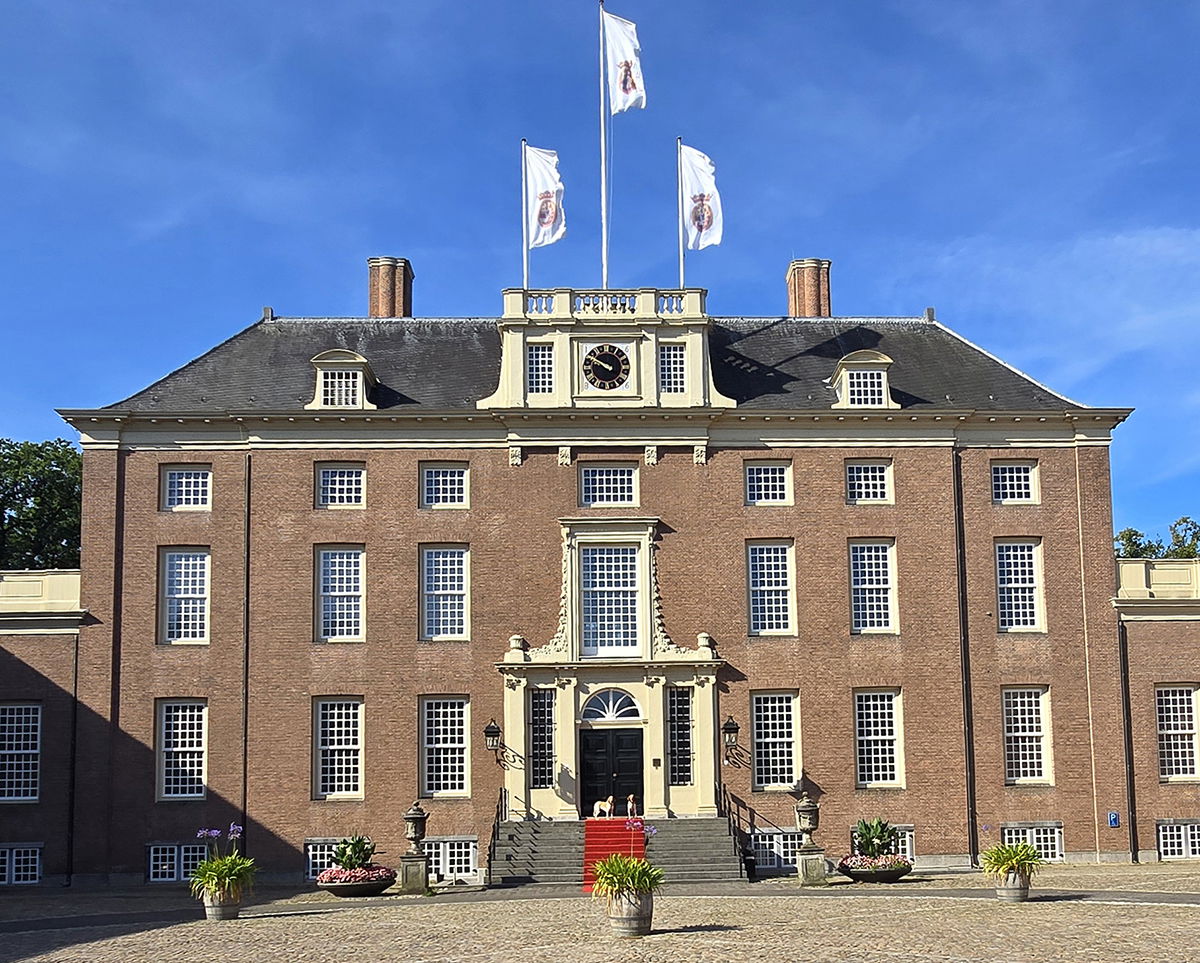
But first I take, as I always do when visiting an estate, a photo of Siena & Giulia in front of the house and in this case Slot Zeist. Look at them standing there, it's as if they belong here.
Through those same doors I walked with my Saskia on July 3, 1980 for our wedding ceremony to promise each other faithfully before the registrar of the civil registry and in the presence of family, friends and colleagues and to fulfill all the duties that are associated with the marital state by law. Pfff. Tensely and with sweaty hands raised we said our yes. In the years before our wedding we also regularly attended radio programs here by Karel Prior "Onder de hanebalken van Slot Zeist" and by Jan Lenferink "RUR".
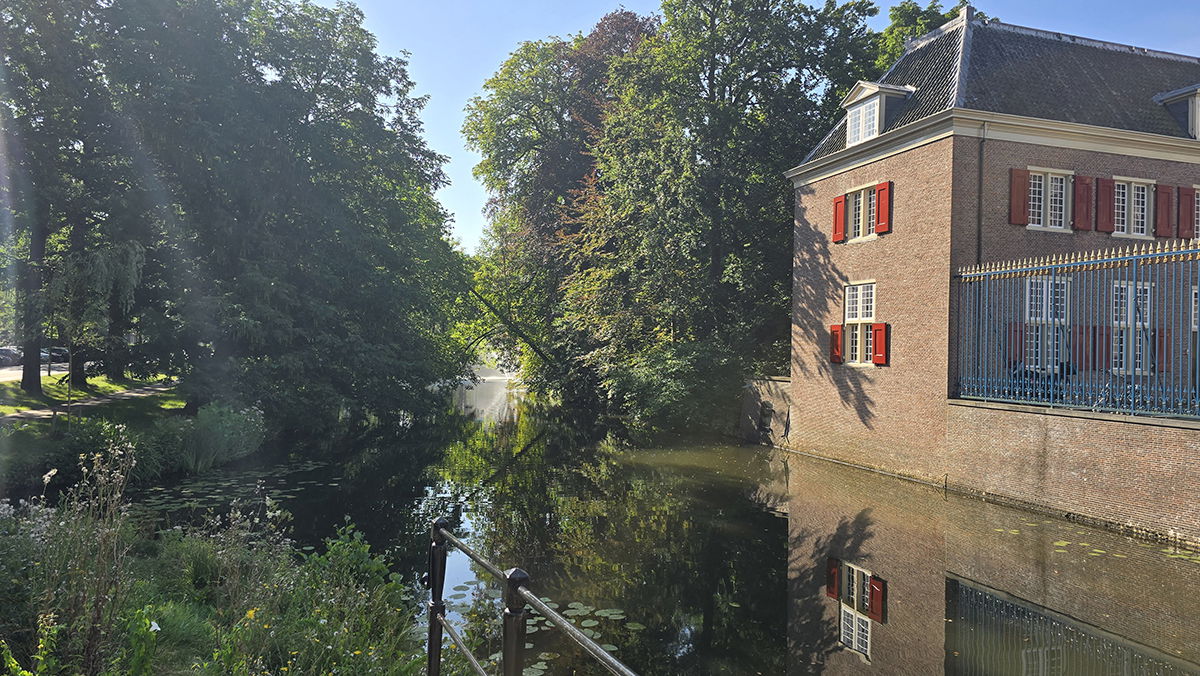
2024 is the anniversary year of the Castle, which is located in the center of Zeist and has been owned by the municipality since 1924. The Castle is only used for cultural purposes, weddings, conferences and meetings, events, parties, dining and is surrounded by an English landscape park with a real moat around it. The moat is connected to the Zeister and Biltse Grift, which was the most important transport artery between Utrecht, De Bilt and Zeist for three centuries and had two locks. In 1924, 3200 ships were still locked in the Koppelsluis on the Koppeldijk Zeist-West. Until the harbor was moved to the Kersbergen estate in 1930, the harbor of Zeist was located on the Waterigeweg in the center of our village. The ditch next to the Waterigeweg is also called Schipperssloot.
I ask my walking friend and avid angler what kinds of fish swim in the moat. He says: “all kinds of fish swim there and just too many to mention”. It is known that the Zeister Hengelaars Vereniging released mirror carp in 2015, but there are also tench, bream, roach and pike. He himself once caught a 70 cm long asp, which can grow to 120 cm long. To fish, you need a fishing permit and a VISpas with you. Only members of the Zeister Hengelaars Vereniging and anglers with a “Zeister Waterenkaart” have the right to fish in the moat.
Next to the bridge in the moat in front of the Castle, a couple of swans has nested since time immemorial, every year on a huge floating nest and in all the hustle and bustle of walkers and traffic. It is a beautiful sight when the young hatch, but because they are so close, mom and dad have to be careful. There are a number of benches around the moat where you can enjoy the beautiful Castle decor with water birds such as wild ducks, moorhens, cormorants, coots and swans in peace. Here in Zeist people talk about the castle pond, but I think the word moat fits such a fairytale Castle better.
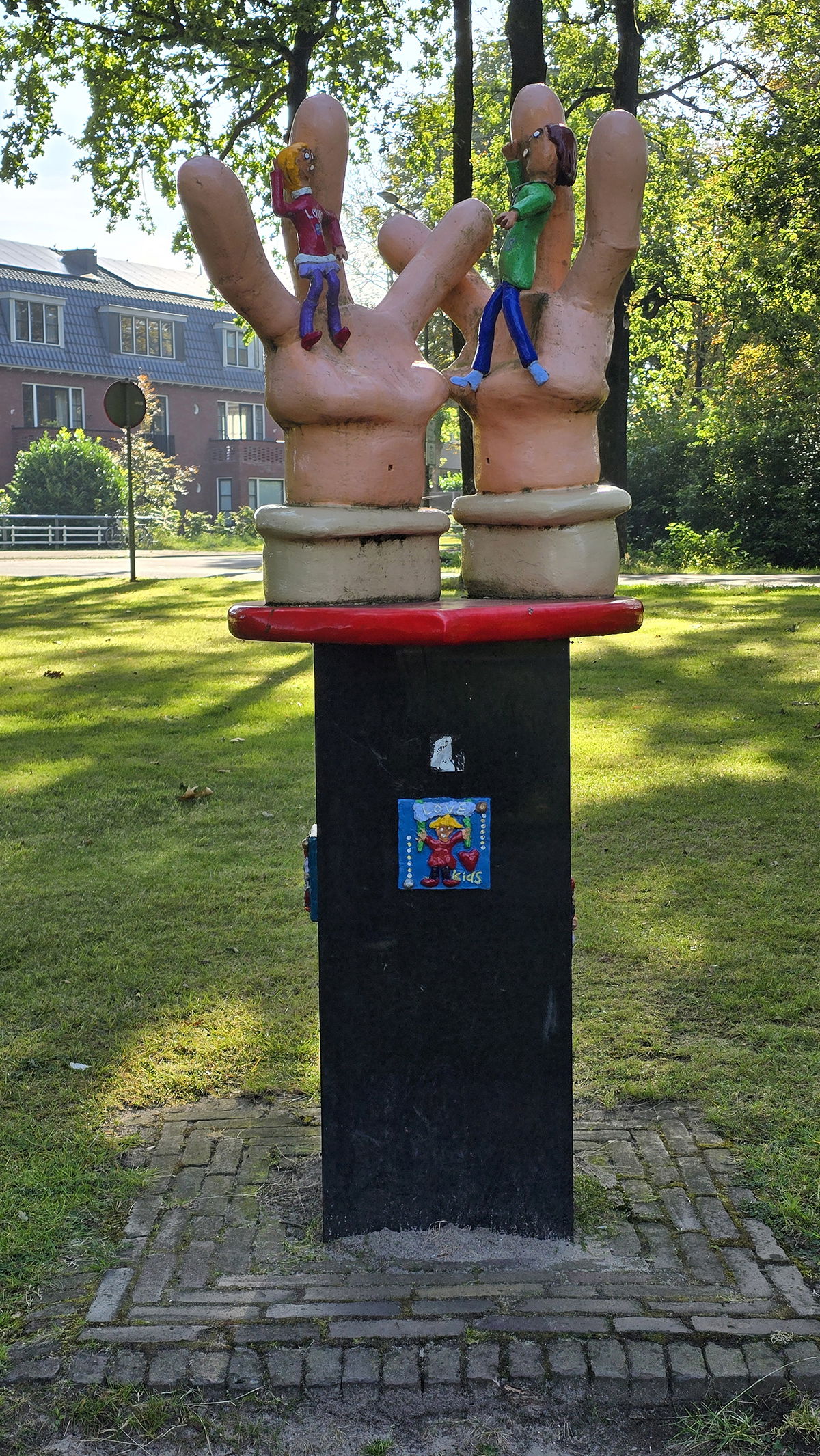
Monument and group of statues
I walk left towards the bridge with tea house and see there under the trees on the grass a black pedestal with an orange monument in memory of the brothers Ruben & Julian who were murdered in 2013. I regularly come across the mother of the brothers with daughter, son and dog during my walks. A strong and sweet woman who has picked up her life again and has to continue with this terrible loss. Deep in thought I stand still for a moment and think of her and her boys. The monument was made by artist Johan Huijzer and consists of two sculptures that look like outstretched hands, it symbolizes in a playful style "the freedom and joy of the children who have passed away" and symbolizes all deceased children.
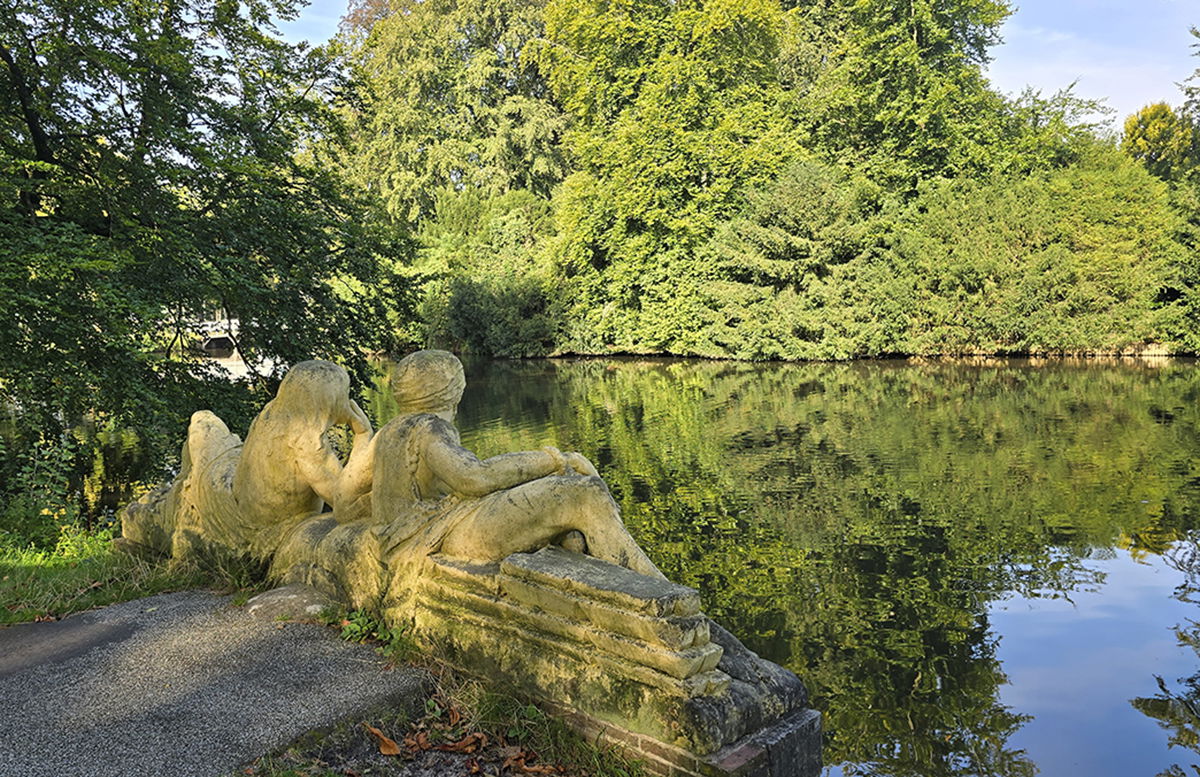
Walking past the high-spouting fountain, I see the sculpture group Europe & Africa looking towards the Castle by the water. The two are also popularly called Adam and Eve. The Antwerp sculptor Albert Xavery (1664-1728) made two symbolic representations of the continents Europe & Africa and Asia & America for the garden, which were placed along the canal on either side of the Castle. The statues were a reference to the status of Willem Adriaan and together with his house became the centre of the world, so to speak. Only this group Europe & Africa has been preserved.
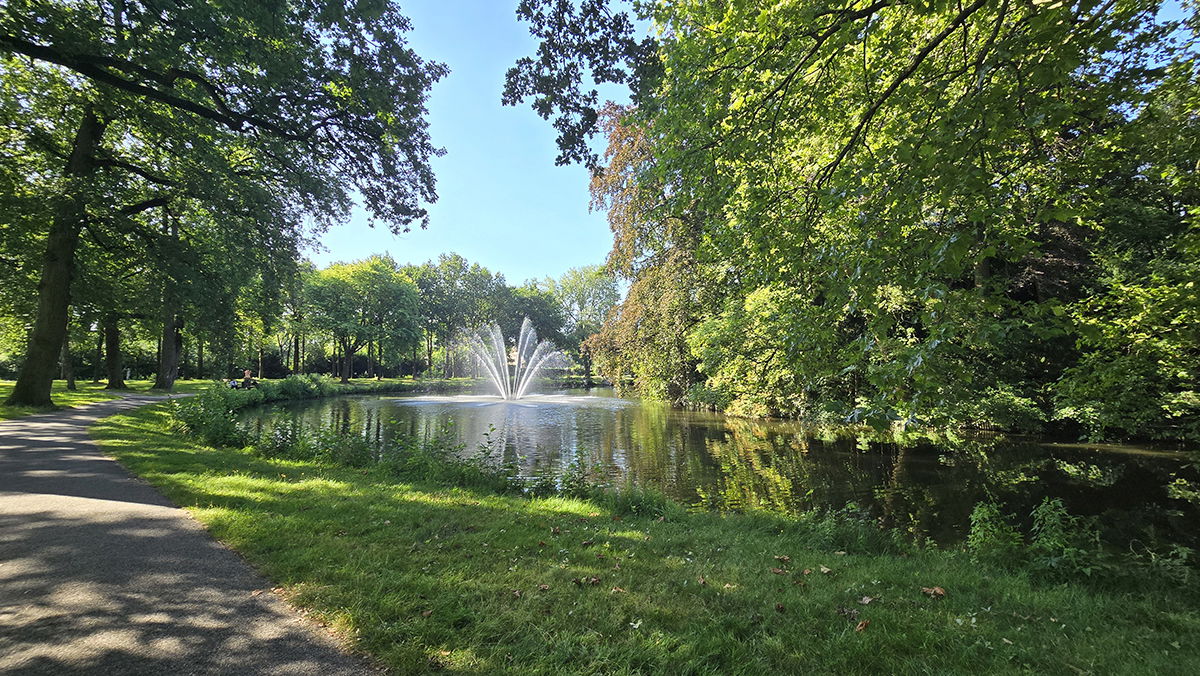
Such a high-spouting fountain in the canal gives the view of the Castle and its surroundings even more allure.
I walk to the small bridge on the Karpersingel before the bridge on the left. Here, in the former coach house and outbuildings of the Castle, a brewery was located from 1745 to 1815. In 1995, a kind of enclave called the “Brewery” was built on this site with apartments and houses in the style of the 17th century. The site can only be entered through an entrance gate. Over the narrow bridge where a lot of car traffic passes, I follow the path along the canal with the Jonathan football club on the left and walk to the entrance bridge at the back of the Castle with the tea house on the other side and to the right of it in the water a team of eleven silver-colored tree trunks.
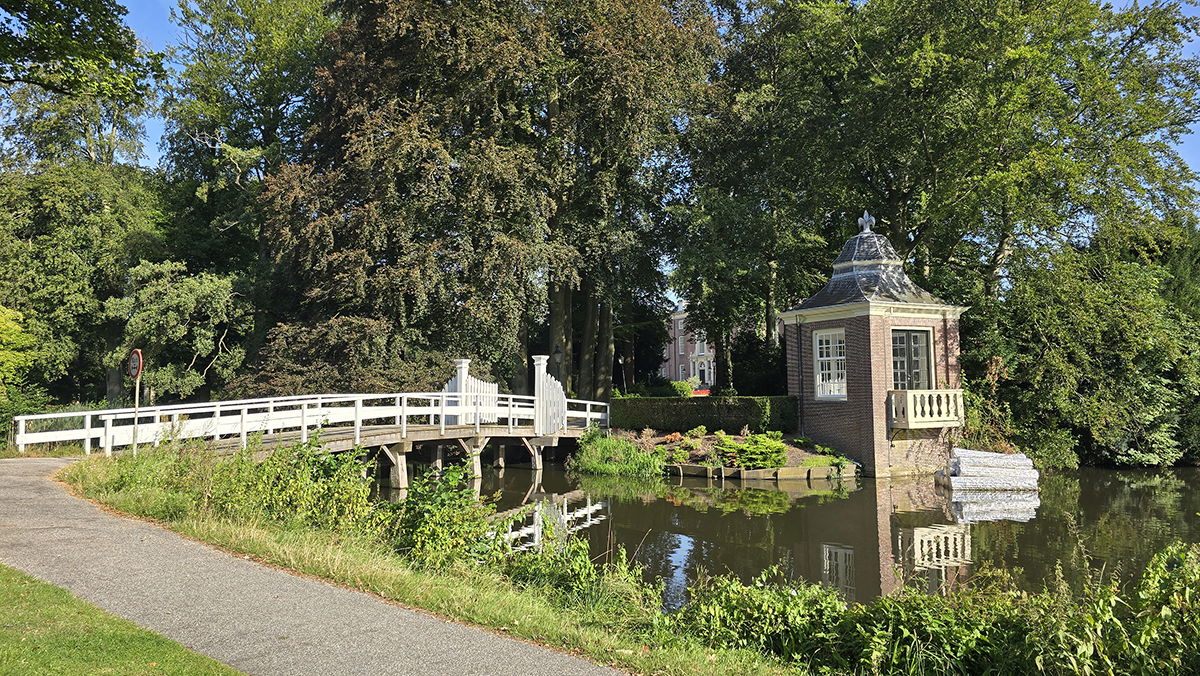
Sculpture route “From Castle to Center”
Around the Castle you will see along paths, garden, canal and fanning out via the Nassau Odijklaan, Broederplein, Zusterplein further over Het Rond, Slotlaan, Walkartpark, 1e Hogeweg and Weeshuisplein about 47 sculptures. These works of art are part of the fifth sculpture route and connect Slot Zeist with the center, as it were. Unfortunately, the explanatory text signs have disappeared for many works, so the viewer must have a great deal of imagination to understand what the artist wants to show you. Without the help of the sculpture route brochure, this will not work. You can find more information at www.slotzeist.nl/beeldenroute and you can pick up a brochure in the Marotzaal of the Castle.
Some artworks have been there for years and I still don't know what they represent. Take the two bronze rings (1997) in the Castle Pond, at the back of the Castle, through which you look at the water and which ducks, coots and moorhens use to sit on and under. It's a pity that a number of old artworks are depicted but not described in the brochure.
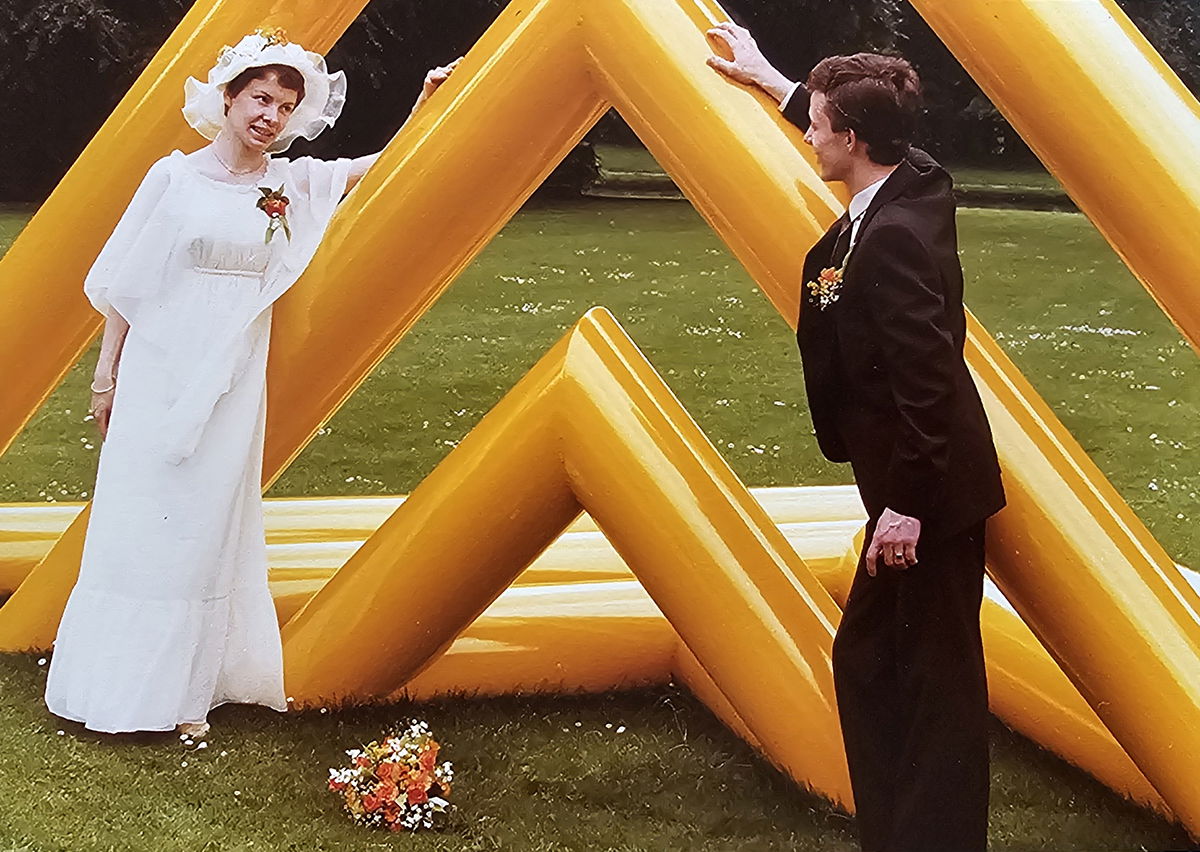
When we got married here at the Castle in 1980, there were also those unsightly (art) works where the photographer absolutely wanted to capture us. Now tell me, is this art? It is certainly artistically made, but to me it feels like I am enterprising but not an entrepreneur. Give me understandable art like that of the ancient Greeks, Egyptians and Dutch masters where you can see what it is. I have never understood the art that requires you to get into the artist's head. Tastes differ and you may find this art beautiful. But it must be said that there are also beautiful works such as the swan floating in the Castle pond on the Waterigeweg side (1984) and in the garden at the back of the Castle, a statue that looks like a horse with a male figure in the back trying to catch a female figure with a torn off arm in front with a lasso. Nice, but do you know what it really represents? Along the Nassau Odijklaan on the Broederplein side lies hidden in the grass and almost invisible to the eye a lifelike polyester hippo head. It is because I walk here and look for images because otherwise I would not have noticed it and I think that almost no one sees the image in the rush of everyday life.
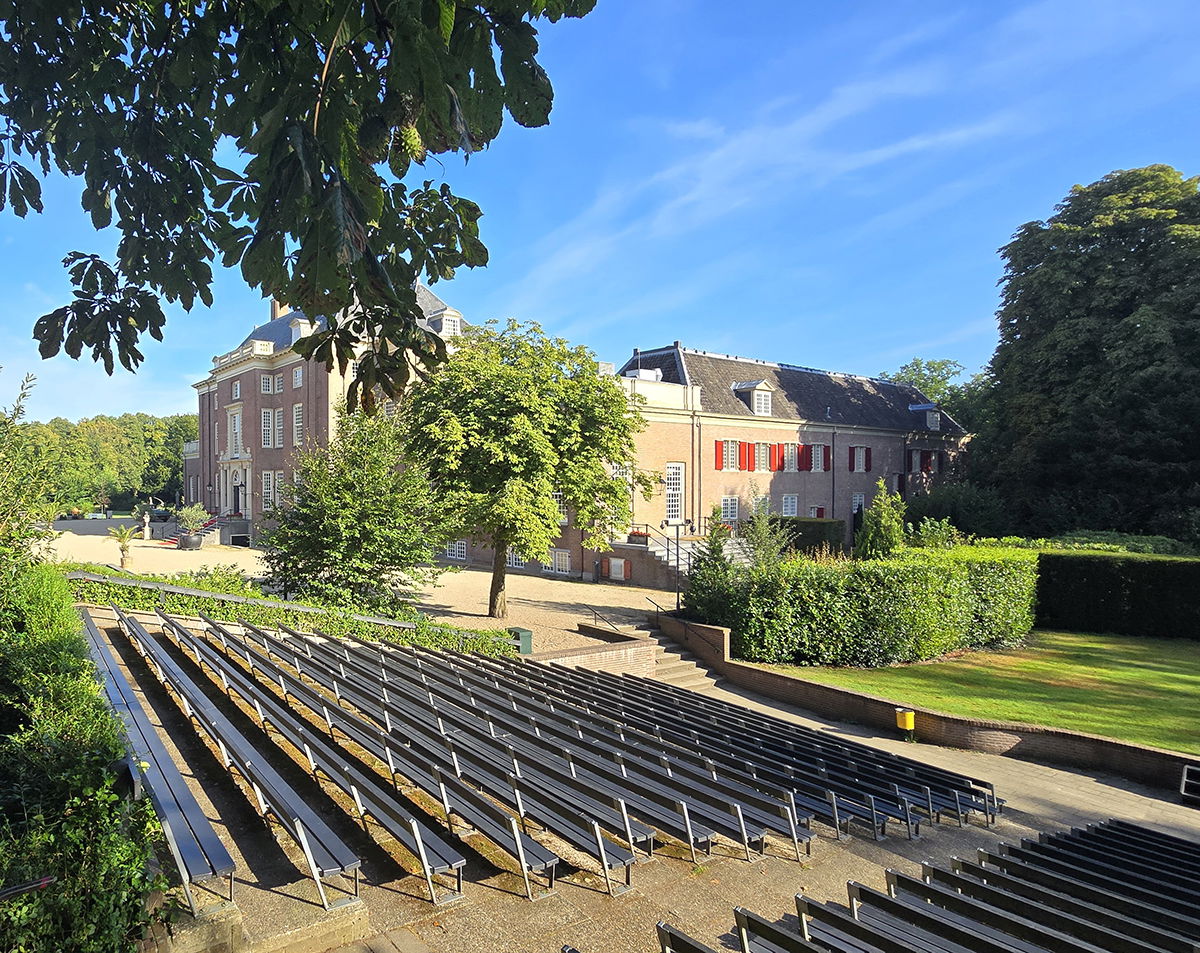
When we got married here at the Castle in 1980, there were also those unsightly (art) works where the photographer absolutely wanted to capture us. Now tell me, is this art? It is certainly artistically made, but to me it feels like I am enterprising but not an entrepreneur. Give me understandable art like that of the ancient Greeks, Egyptians and Dutch masters where you can see what it is. I have never understood the art that requires you to get into the artist's head. Tastes differ and you may find this art beautiful. But it must be said that there are also beautiful works such as the swan floating in the Castle pond on the Waterigeweg side (1984) and in the garden at the back of the Castle, a statue that looks like a horse with a male figure in the back trying to catch a female figure with a torn off arm in front with a lasso. Nice, but do you know what it really represents? Along the Nassau Odijklaan on the Broederplein side lies hidden in the grass and almost invisible to the eye a lifelike polyester hippo head. It is because I walk here and look for images because otherwise I would not have noticed it and I think that almost no one sees the image in the rush of everyday life.
I walk to the back of the Castle and see that Siena & Giulia are looking up to be allowed to pose on the steps. Let go of the belts upstairs and take a quick snapshot. It's beautiful how you can see the garden with the pond behind it from so high up. I think there are at least a hundred ring-necked parakeets nesting in the trees behind the Castle, which fly over to the Walkartpark, Burgemeesterspark (park Beek en Royen), Molenbosch and which you can hear and see there chatting busily.
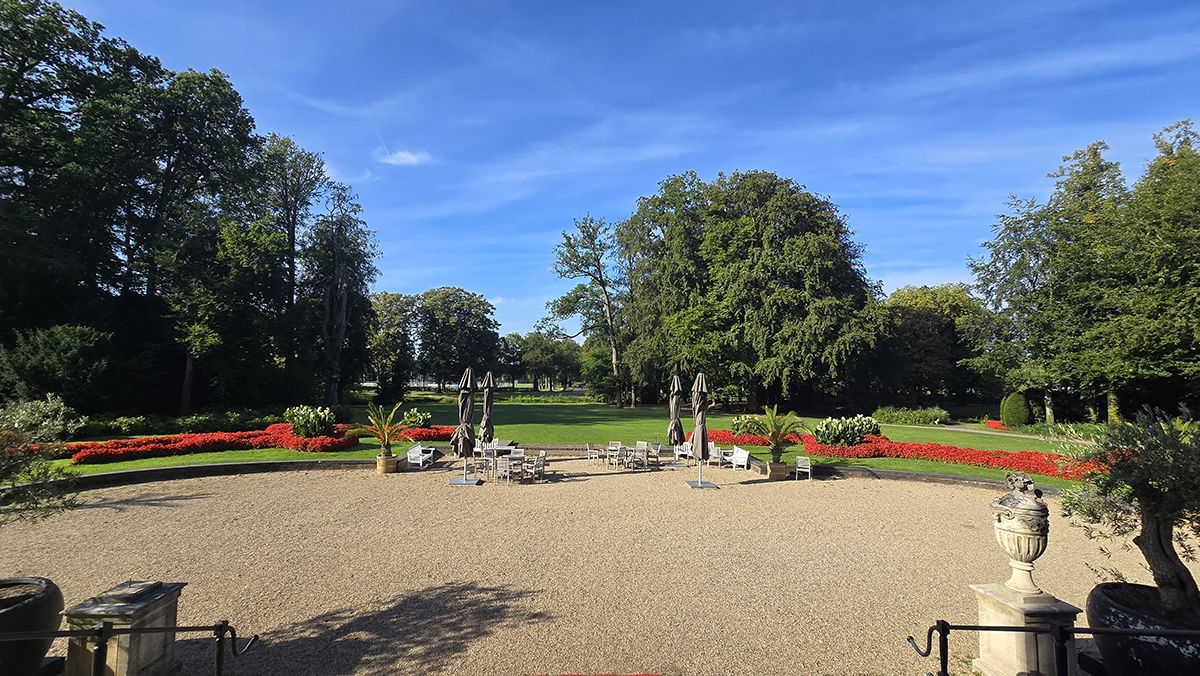
In the evening, the whole group returns to the Castle garden to talk about the day together.
Walking further around the Castle and pond, I encounter many more works of art and walk through the Orangerie in the right wing and drink a delicious cup of coffee in front of the Castle in peace and enjoy all the beauty and people around me. Here you can also enjoy a High Tea, lunch or snack and drink but you can also opt for a Castle Garden Picnic behind the Castle.
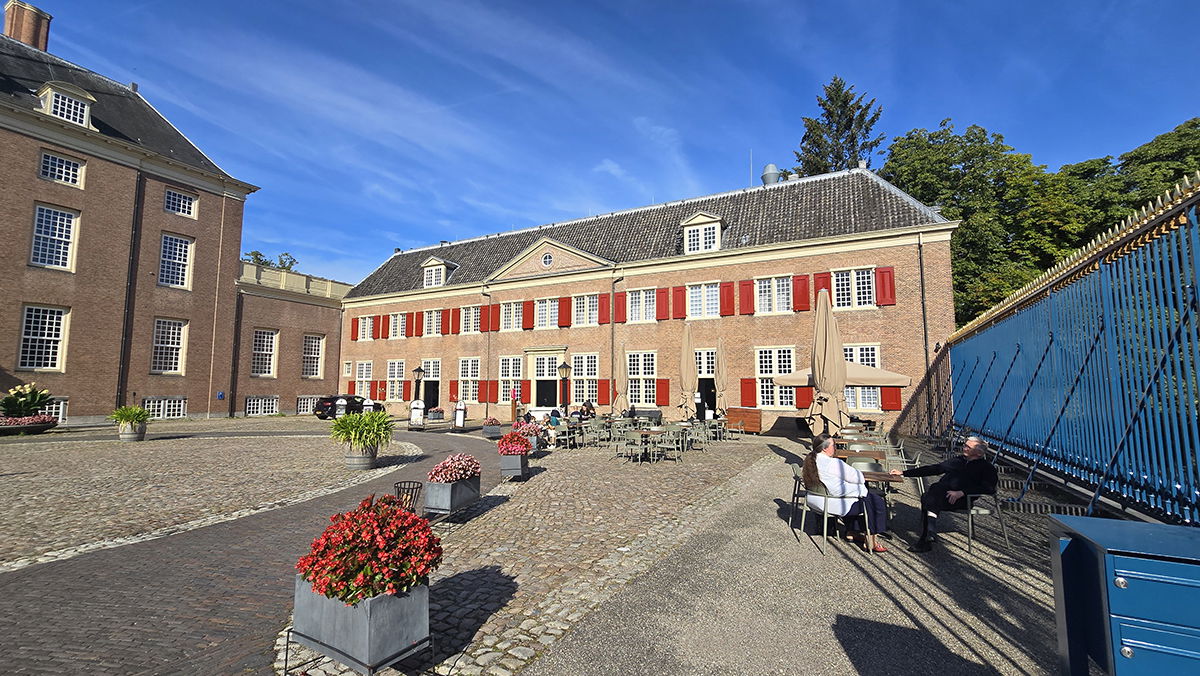
It is time for the walk back and I walk along the narrow path along the Nassau Odijklaan with a detour via Broederplein and Zusterplein to Het Rond.
From the Waterigeweg there is a short-mown green lawn in the middle of the road with beautifully colored flower beds and clipped conifers. This is in front of the Nassauhuis that used to be the Boys' School of the Evangelical Brotherhood with De Posterij next to it in the old post office with apartments, a kitchen and wine shop and Fusion restaurant MIDO. On the other side is Restaurant & Café du Paris Hermitage.

On the other side of the 1e Dorpsstraat this colorful carpet continues but then in its natural stone containers filled with flowering red and white plants. The containers with wide edges all around invite you to sit on them. With on one side our picturesque Town Hall old and new and on the other side Hotel and Theater Figi with in front of it a silver colored ball called "Light" where water bubbles up on the sides and is an ideal opportunity to let Siena & Giulia drink. Everything looks cheerful and neatly maintained. I can still remember that during the redevelopment of Het Rond and the Slotlaan this was called a tapis de fleurs (flower carpet). Further along the Slotlaan the central axis with statues continues up to the intersection of 1e and 2e Hogeweg as tapis verte (green carpet) which is however boring and gray so more tapis gris.
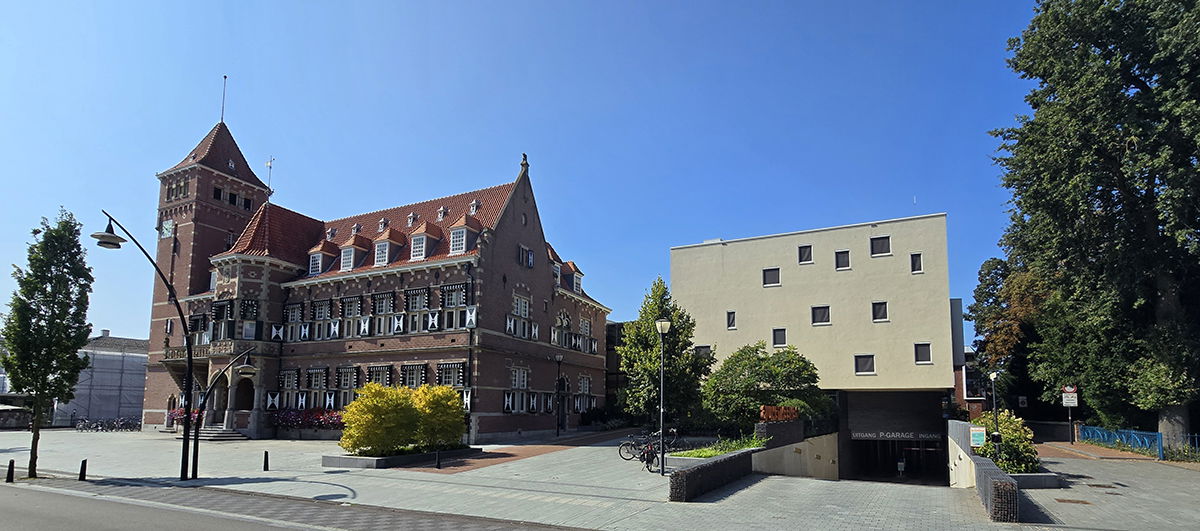
Here my walk ends and I can heartily recommend a walk in my footsteps.
In the gallery of the website you can find many more beautiful photos.
Zeist is so beautiful and how lucky we are to live here.
Until the next walk at the country estate Lommerlust, Arnie Della Rosa
You can read my walking stories at https://www.als-bomen-en-stenen-konden-praten.com but also together with the columns of other Zeister columnists at https://www.zeistermagazine.nl
Je kunt mijn wandelverhalen lezen op https://www.als-bomen-en-stenen-konden-praten.com maar ook samen met de columns van andere Zeister columnisten op https://www.zeistermagazine.nl
Brief overview of Zeist Castle
Addres: Zinzendorflaan 1
The oldest mention of Seyst dates from 1165
The land on which the castle was built was mentioned in 1165 as the property of a certain Godefridus van Seyst, without mention of a house. In 1536, mention is made of construction when "dat huys te Seyst, vry eigen goed" is recognized by the States of Utrecht as a knight's manor. A knight's manor is land on which the house and associated buildings of a knightly man are located.
1677-1686
Construction of Zeist Castle as a pleasure garden for Willem Adriaan van Nassau (1632-1705), Lord of Odijk, Kortgene, Zeist and Driebergen, married to Elisabeth van der Nisse (1639-1698), Lady of Heinkenszand, Overzand and Driewegen
- Willem Adriaan was, through his father Lodewijk van Nassau-Beverweerd (1602-1665), grandson of Prince Maurits van Oranje (1567-1625), great-grandson of “The Father of the Fatherland” Willem van Oranje (1533-1584)
- purchase of the lordship of Zeist and the dilapidated medieval castle for 5,000 guilders from the States of Utrecht and Willem Adriaan therefore became Lord of Zeist
- design by Leiden city architect Jacobus Roman (1640-1716)
- interior design mainly by French Huguenot Daniel Marot (1661-1752)
- the largely preserved wall and ceiling paintings are reminiscent of the French Baroque
1705
- son Lodewijk Adriaan count of Nassau (1670-1742) lord of Odijk, Blikkenburg and Kortgene and grandson Willem Adriaan II (1704-1759) count of Nassau lord of Zeist and Driebergen, lord of Bergen
1745
- Cornelis Schellinger (1711-1778), an Amsterdam ironmonger, buys the Castle for 157,000 guilders for the Moravians who establish “Ortsgemeine” here. Schellinger thus became the baron of Zeist and Driebergen
- Cornelis Schellinger came to a financial agreement with Count Nicholaas Ludwig von Zinzendorf-Pottendorf (1700-1760), founder of the Moravian Church, that the latter would be given a wing of the Castle and the meadows in front of it. The houses of the Moravian Church would later be built on this. To the right of the driveway, space was made for the unmarried sisters and widows (the Sister House and the Widow House), on the other side for the unmarried brothers (the Brother House). Later, these were called the Sister Square and Brother Square respectively. Because the brothers and sisters had to provide for themselves, they founded various businesses such as a bakery, a button factory, a silversmith's and a tinsmith's. Their products were sold in the Broederhuis. In fact, this created the first department store in the Netherlands in Zeist.
1767
- Maria Agnes Zu von Dohna (born von Zinzendorf-Pottendorf) (1735-1784), free lady of Zeist married to Count Moritz Wilhelm Heinrich Zu Dohna-Schlodien (1737-1777)
- Maria never lived here
- Cornelis Schellinger moved after the sale of the Castle to Broederplein 25-29 (Schellingerhuis) and is buried on the Godsakker behind the Zusterplein. 1784 - Johannes Renatus (Jan) van Laer (1731-1792) lord of Zeist married to his cousin Cornelia Johanna Verbeek (1736-1804)
- member of the Moravian Church, rented out the Castle but continued to live on the Zusterplein
1792
- Johannes van Laer (1775-1816) last lord of the castle of Zeist married to Charlotte Beuning
1816
- Cornelis Renatus van Laer (1767-1842) married to Anna Cecilia van Laer (1770-??)
- Jacob van Laer (1769-1824) married to Anna Cornelia Lugt (1739-1799), Christiane Salomé Verbeek (1742-1798) ) and Anna Johanna van Laer (1739-1799)
1818
- sale to Coenraad Willem Wijborgh (1772-1844) married to Johanna Sonmans Boreel de Mauregnault (1775-1818)
- direct resale to Evangelical Lutheran Community in Berbice in British Guyana
- Castle and the squares are separated
- until 1830 the Castle was regularly rented out
1830
- Jonkheer Jan Elias Huydecoper van Maarsseveen (1798-1865) married to Maria Isabella Anne Josine Charlotte baroness Taets (1798-1865)
- restoration of the Castle in the Empire style (imperial style from the time of Louis Napoleon)
- application of Biblical images in the Willemszaal by the Dutch painter Cornelis Kruseman (1797-1857) - development of the back garden into a landscape park by Jan David Zocher (1791-1870)
1867
- Henriëtte Maria Jacoba Labouchère-Voombergh (1830-1904) married to Charles Bernhard Labouchère (1817-1897)
- ceiling paintings in the Willemszaal were removed
1867
- Henriëtte Maria Jacoba Labouchère-Voombergh (1830-1904) gehuwd met Charles Bernhard Labouchère (1817-1897)
- plafondschilderingen in de Willemszaal werden verwijderd
1908
- mr. Ernest Samuel Labouchère (1856-1932) gehuwd met Marie Adelaïde Mathilde van Weede (1860-1934)
- Henriëtte Constance Adèle Labouchère (1860-1935) gehuwd met Jonkheer Frank Karel van Lennep (1865-1928) bewoonden een gedeelte van het hoofdgebouw en de linkervleugel.
1924
- N.V. Bouw- en Exploitatiemaatschappij Heemstede in Utrecht buys the Castle for demolition
- the municipality of Zeist buys the Castle six weeks later for 130,000 guilders with the park and the strip of forest between the 'extended' Koelaan and Waterigeweg
1925
- accommodation for various committees and municipal offices
1940
- requisition of the castle by Gutsche, Major der Deutschen Wehrmacht to establish the Ortskommandantur
- due to negligence of German soldiers, the castle was ravaged by fire in the night of 8 to 9 February 1945, the left wing burned down almost completely
1945
- after the liberation the castle served as a prison for political prisoners
- later the Entertainment Committee for the Canadian troops and the Intendance for Overseas Territories moved into the building
1948
- in the park, as part of a project for the unemployed, an open-air theatre was built with seating for 1000 people
1953
- the Castle was set up to accommodate victims of the Zeeland flood disaster
1957
- on 7 January the starting signal was given for the extensive restoration under the leadership of architect Johannes Bernardus baron van Asbeck (1911-2010), with the furnishing and decoration carried out by Jan Ruys
1960
- renovation of the castle to the original baroque style, using authentic demolition material from other baroque buildings.
1969
- completion of the restoration of the side wings
- reopening on 8 October by H.R.H. Prince Claus (1926-2002)
Claus George Willem Otto Frederik Geert, Prince of the Netherlands, esquire of Amsberg
born as Klaus-Georg Wilhelm Otto Friedrich Gerd von Amsberg
2006
- start of 1-year renovation
- the invisible installation of installations and replacement of existing parts
- the visible results are the historical colour schemes of the wall paintings, the interior painting and work on the antique furniture
- No expense or effort was spared for this extensive restoration. For example, the wall covering in the blue hall was re-produced on a seventeenth-century loom of this exceptional size. Based on the original designs, the aim was to restore the Castle to its original state as much as possible with great craftsmanship, but at the same time the necessary changes were made to meet the technical requirements of this time.